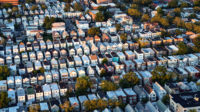In our current national housing crisis, there are occasionally lotteries to select tenants for new or renovated affordable multifamily buildings. For example, last year, nearly 94,000 people applied to rent 104 moderately priced units in an apartment house on the Lower East Side of Manhattan in New York City. You figure the odds on that one.
In a way, many of us have won—or lost—a kind of housing lottery. Did you inherit your house? Did you buy at the low end of the market a while back so your mortgage has remained a reasonable, fixed cost—and you’ve been deducting the interest from your income tax? Has your home gained significant value so you can borrow against it to renovate your kitchen or help send your child to college? Do you live in an apartment you don’t own, but in a city with regulations that keep your monthly rent fairly stable?
Or are you one of the unlucky people who lost the lottery? Your home ended up underwater when the housing bubble burst 10 years ago. You’re a young adult trying to make your way in the big city, but all you can afford is an illegal basement apartment with four roommates. You’re working two jobs at minimum wage and still spending more than half your earnings on housing. Your urban neighborhood is gentrifying, and your landlord is jacking up the rent to force you out. You or a family member had a health emergency or other unexpected expense that caused you to miss a couple months’ rent, and now you’re facing eviction.
The lack of adequate affordable housing is a vast, complex conundrum that touches tens of millions of American lives across a socioeconomic spectrum that begins with the chronically homeless—up by 12 percent since 2016, despite low unemployment and a thriving economy—and stretches into the middle class. Under a new city government plan to create more affordable housing in New York, 20 percent of the units in the initiative would be set aside for families making, astonishingly, as much as $142,000 a year.
Of course, what that really means is that in cities like New York and San Francisco, with soaring housing markets, you can make a good salary and still be paying more than 30 percent of your income—the national recommended benchmark—to put a roof over your head. When the average price to buy an apartment in Manhattan is $2 million, or the median cost of a house in San Francisco is $1.6 million, you probably need to win the real Lotto just to live in either place.
But in smaller, non-coastal cities, residents are also feeling a big pinch. The obvious reasons: the median home price rose 41 percent faster than overall inflation between 1990 and 2016. And the supply of housing is nowhere near meeting demand: according to the National Low Income Housing Coalition, the U.S. is short 7.2 million affordable rental units, 1 million of them in California, which has more of the highest housing markets than any other state. The ever-widening gap between what people earn—whether low-income or middle-class—and what decent housing costs is one of the most acute and poorly addressed problems our country is facing.
We do not pretend to know the answers. But we know that architects, with their design, construction, and problem-solving skills—and often deep knowledge about how cities work—can assist policymakers, developers, community leaders, and other stakeholders in grappling with a crisis that is largely being confronted on the local, not the federal, level.
In this issue of RECORD, we have begun to explore the severity of the affordable-housing shortage, with close-up views of three very different urban markets: Oakland, New York, and Orlando. We’ve also delved into the vexing question of gentrification, to ask the question, can low income neighborhoods be improved, as they should be, without threatening the displacement of longtime residents? We have talked with one of the nation’s leaders on homelessness, Rosanne Haggerty, about new strategies that can help families, veterans, and others deeply in need of obtaining permanent homes. And, lastly, we’ve looked at the wider world to find models of innovative architecture for housing a broad range of communities.






